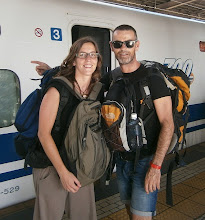Entrem a Gal.les creuant el canal de Bristol i ens situem a la península de
Gower. Ens han recomanat una zona de costa amb unes petites cales i hi anem
directe. El primer que trobem és un
càmping de luxe excepcional, el qual ofereix allotjament en uns acollidors
bungalows i unes clàssiques “camperavans”, en un espai completament verge amb
les millors vistes de Three Cliffs Bay. Un lloc molt especial on potser algun
dia hi farem estada. Aquest cop però el nostre camp base és en un petit B&B (al diminut poble de Kittle) i un parell de locals per menjar a Bishopston.
L’endemà caminem fins a la platja de Pobbles on ens banyem a primera hora i
veiem ràpidament com baixa la marea. La petita cala rodejada de parets rocoses
on ens trobem es converteix en un passeig de mar on pots caminar quilòmetres
i quilòmetres vorejant tota la costa, travessant d’un costat a l’altre i
descobrint les filtracions d’un riu que es submergeix entre corrents fins
arribar al mar. Una escena increïble! I per nosaltres (gent del Mediterrani)
poc comuna. A diferents moments del dia
anem a visitar la zona i el dia següent anem a Rossili per veure com la pujada
de la marea rodeja i converteix una zona
de terra, en una ïlla.
Agafem el cotxe i resseguim la costa de Gal.les, fent una parada a Tenby,
bonic, però menys verge i impressionat del que hem vist, pugem fins a
Aberystwyth (nom impronunciable per nosaltres) i un cop en aquesta alçada del
mapa, la nostra ruta avança cap a l’oest entre muntanyes i
giravolts que ens endinsen a l‘interior del país. És un paisatge verd de
petits boscos i molts camps plens d’ovelles, un clima plujós i més fresc, i a
mesura que avancem dóna més sensació d’aïllament i una forta personalitat; ens
parem a petits poblets com Llanguri i Rhayader abans de tornar a terres
angleses. El nostre pas per Gal.les ha valgut molt la pena.
Després d’unes milles, arribem a Stow-on-the-wall, poblet turístic de
carrers ordenats, restaurants, sales de tè i botigues que recordarem també per
no trobar-hi cap local on veure el futbol; fet estrany a Anglaterra, no? Des
d’allà voltem per Broadwell, Bourton-on-the-water i Stratford (poble natal de
Shakespeare).
Gairebé al final del viatge, passem un dia a Oxford, ciutat que ja coneixem
i ens desviem fins Wendover, on l’Eduard havia viscut una temporada. Ja només
ens queda arribar de nou a Bournemouth. Ens despedim de la família Fulton, ens trobem amb la Judith i en Joan que
acaben d’instal.lar-se junts a la ciutat i agafem el vol de tornada a casa.
Aquest estiu, un viatge descansat i poc llunyà, però tota experiència a
l’estranger sempre és positiva.
We headed Wales
through the Bristol Channel to arrive in the Gower peninsula, we drove direct
to an unspoilt bay highly recommended. Once there, we found a luxurious camping
that offered cosy bungalows and nice campervans with the best views of Three
Cliffs Bay. However in those days we were staying in a small B&B in Kittle
and having our meals in a small place in Bishopston. Next time, maybe we’ll
stay in that splendid camping.
We took a nice walk to
another bay called Pobbles where we swam early in the morning and we quickly
realised how the tide was going out. Our small rocky bay became a wide sandy
promenade in a just few hours. We walked along the sea and through a river leak
across the beach. That was a wonderful picture of the coast. We (Mediterranian
people) were amazed by the tide coming in and going out twice a day. Rossili was another great example to gaze how
the tide changed the landscape.
We drove following the
Wales coast, stopping for a while in Tenby (a nice village, but more busy and
touristic compare to the other ones) and we head north until Aberystwyth (an
unpronounceable name for us). Once there, we drove to the east through a green,
rainy landscape following twisty roads. It seemed to us an isolate and
particular land . We took a break in Llanguri and Rhayader before coming back
to England. Our days in Wales had been great!
After some miles, we
arrived in Stow-on-the-wall, a touristic small village full of restaurants, tea
places and nice boutiques, we’re also going to remember that place for being
the only English village where It was so difficult to have a beer watching a
football match on TV, awkward, isn’t it? From there we visited Broadwell,
Bourton-on-the-water i Stratford (Shakespeare birthplace).
Almost at the end of
the trip, we spend a day in Oxford and we payed a
quick visit to Wendover where Eduard had been living long time ago.
Eventually, we were in Bournemouth again. We saw off the Fulton’s family, we caught up with some Catalan friends who just moved to England and we took our flight back home.
Eventually, we were in Bournemouth again. We saw off the Fulton’s family, we caught up with some Catalan friends who just moved to England and we took our flight back home.
Anyway, we didn't travel too far last summer, but it was as interesting as it is to spend some holidays anywhere in the world.



